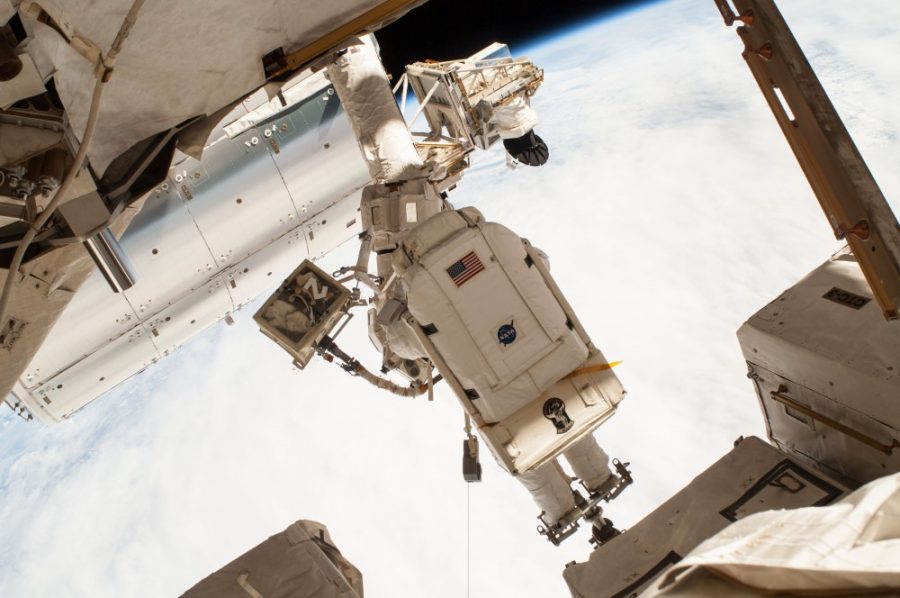A NASA-funded lab at the University of Arizona’s Center for Applied NanoBioscience and Medicine has developed a way to test how the human gut will react to cosmic radiation in space. This new technology mimics the entire micro-environment of the human gastrointestinal system — and it all fits on a microchip the size of an SD card.
“This is really a tool to learn what will be the makeup of the gut microbiome in space when it’s exposed to cosmic radiation,” said Frederic Zenhausern, director of the Center for Applied NanoBioscience and Medicine, and a professor of basic medical sciences and radiation oncology.
This foundational “gut-on-a-chip” technology is part of NASA’s plan to put humans on Mars. The International Space Station is only about 250 miles away, Zenhausern said. If astronauts have a medical emergency, they are brought home to be treated.
“Now if we want to go to … Mars, it would be 50 million miles away, so the journey will be long,” Zenhausern said. “We need to come up with a way of bringing technology to [diagnose] most of the diseases in space.”
Studying the effects of space on the human body is a challenging task, particularly when you want to look at the effects of cosmic radiation.
It’s very difficult to find human models to study the effects of radiation on, unless you are using cancer patients, said Jerome Lacombe, assistant scientific investigator at the College of Medicine-Phoenix Center for Applied NanoBioscience and Medicine.
RELATED: Headlines from space: Possible planet in the Kuiper belt?
Using animals won’t work either, as the microbiome of a human gastrointestinal system is completely unique. That’s where this microchip comes in. It allows scientists to radiate normal human cells in a controlled environment and study the results, Lacombe said.
In order to truly mimic the human gut, researchers had to design a way for many different types of bacteria to coexist in the same environment. This chip contains both aerobic human cells, which require oxygen, and anaerobic bacterial cells, which can only grow without oxygen, interacting in different chambers, according to Lacombe.
These two different cell populations can reside in close proximity to each other and communicate through a nano-porous membrane, Zenhausern said. Much like the layers of a cake, diverse types of cells each occupy separate levels on the chip in an environment tailored to their specific needs.
“What happens is the cells can be contained in their different environments, happy to grow and be alive,” Zenhausern said.
This is the first time researchers have been able to show they can control an environment to accommodate both aerobic and anaerobic bacteria, according to Zenhausern. The chip is equipped with sensors and mechanisms that allow researchers to regulate the flow of nutrients to each level.
The information researchers glean from this microchip will be useful in preparing for whatever strange diseases or bacteria astronauts are exposed to once in space, Zenhausern said. By studying the effects of cosmic radiation on the gut’s cells, they will have a better idea of what to expect once humans are actually on Mars.
“Maybe we can think in the future to have probiotics that we will be giving to the astronauts to in fact prevent or treat [damages from radiation], depending on the exposure,” Zenhausern said.
RELATED: Creating Mars on Earth
This technology doesn’t just have applications for future space travel. Both Zenhausern and Lacombe see opportunities for it to be used now, to develop drugs that could help mitigate cell damage caused by radiation.
“We [have learned] so much more about radiation biology and the effect of the microbiome interacting with human tissue,” Zenhausern said. “We have a different project now derived from that, where we are looking at the effect of radiation toxicity in the case of radiotherapy treatment, because right now there are a lot of things that we don’t know when cancer patients go under radiotherapy.”
The chip could also provide a platform to test new drugs, instead of using animal models. It could be a way to discover new biomarkers for gastrointestinal diseases, Lacombe said.
The gut-on-a-chip research is funded by a grant awarded to Wake Forest Institute for Regenerative Medicine by NASA’s Translational Research Institute at Baylor College of Medicine. The Translational Research Institute is working to develop ways to lower human risk on long space exploration missions.
Follow Hannah Dahl on Twitter









